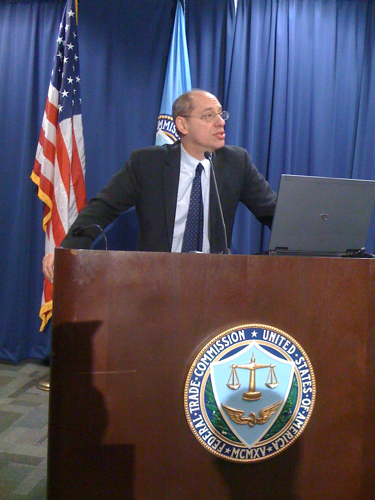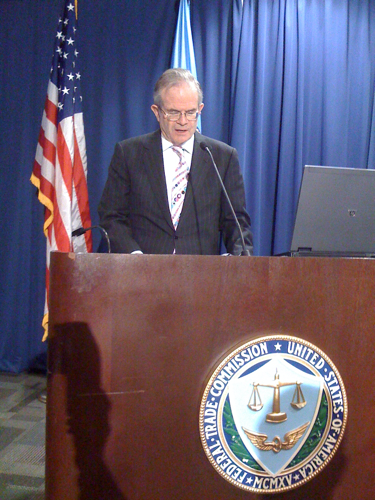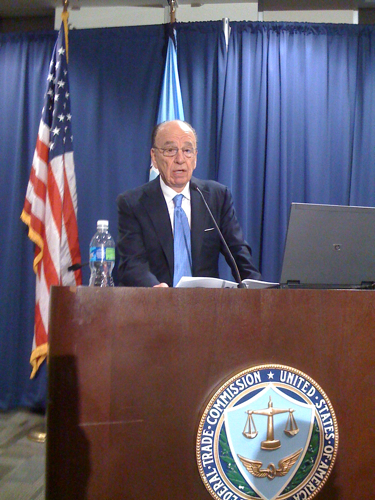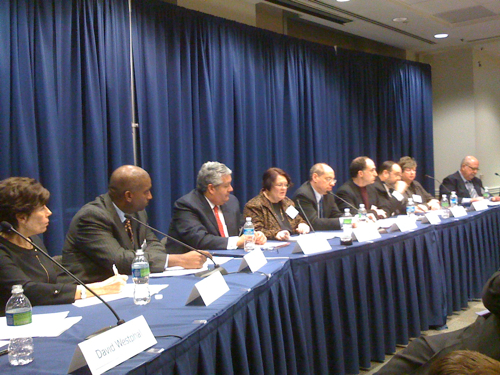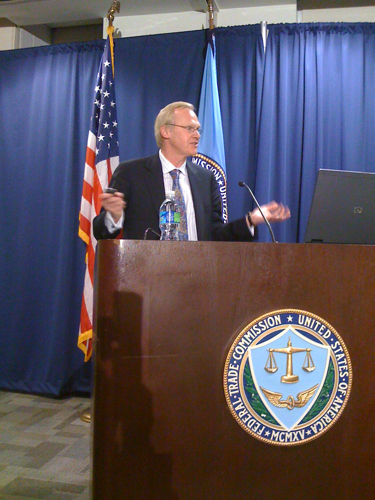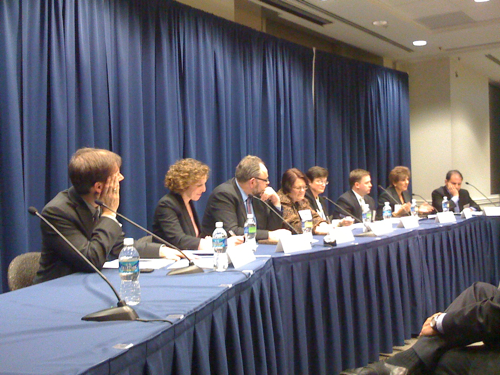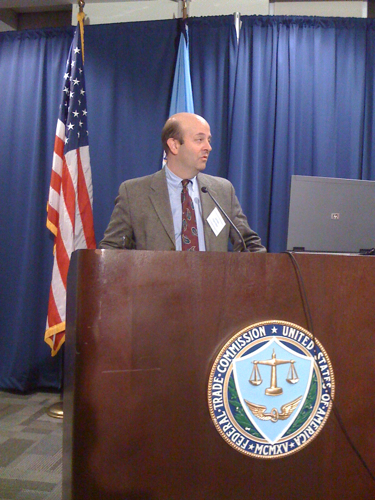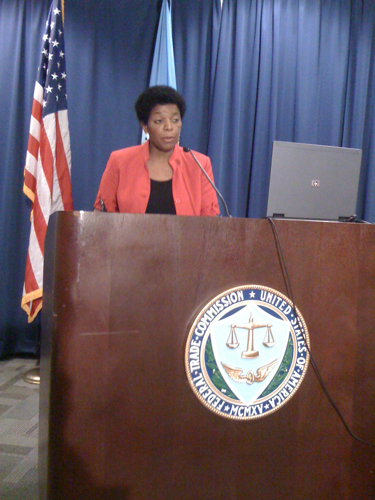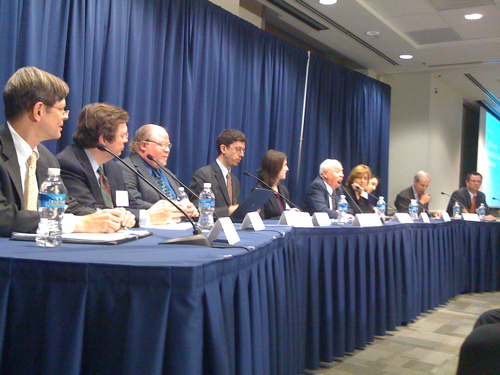Live Blogging The FTC Workshop On Journalism & The Internet
I’m at the FTC’s “Journalism & Internet Age” Workshop in Washington DC today, where we’re expecting addresses from Rupert Murdoch and Arianna Huffington, along with Josh Cohen of Google News and a variety of panels. I’ll be on one of those panels later today. I’m going to do a big live blog of things I […]
I’m at the FTC’s “Journalism & Internet Age” Workshop in Washington DC today, where we’re expecting addresses from Rupert Murdoch and Arianna Huffington, along with Josh Cohen of Google News and a variety of panels. I’ll be on one of those panels later today. I’m going to do a big live blog of things I find interesting, and you can also watch the webcast via this page.
Jon Leibowitz (above), Chairman of the Federal Trade Commission is now welcoming us. Journalism is in trouble. New ad model and other changes causing disruption, including self-inflicted wounds.
Why is the FTC doing this workshop? FTC has policy functions assigned to it to investigate new developments in the marketplace and make legislative recommendations. With radio, recommended act that made the FCC. Workshop today intended to bring out more facts. “The bottom seems to be falling out of the news business” as consumers shift their habits. Though newspapers were still profitable overall in 2008; TV still main way people get information. But newsrooms of dailies may employ 25% fewer people. Was at the LA Times recently and felt sense of shock at rows of empty seats in what was bustling newsroom.
Short term has played a factor, leveraged debt, recession, but “the internet is dramatically reducing revenue for news organizations.” Citing Pew report that problem papers face is revenue, decoupling of advertising from news. There’s still an audience.
Gone are the days when consumers would be exposed to only a few outlets; many ways for consumers to get info and ads. We can get news when we want; advertise on Craiglist for free. This should all be good.
Does what’s happening to journalism fit the usual model of creative disruption?
Before advertising in the 1800 helped papers, the government helped fund news by requiring all those ads businesses have to place.
News has high production cost but low consumption / copy cost. Consumers can free ride, which makes things harder for producers. So market of news needs more study — it’s a public good. And not just any market. Changes in journalism not just profits and losses for various organizations but impacts how we govern ourselves.
Future workshops will look at things like changes to anti-trust laws, government funding and various other options.
We’re are not going to undo the profound changes of the internet nor should we want to. But should look to protect democracy.
Next up (and above), Paul Steiger, Editor-in-Chief, President and CEO, ProPublica & Former Managing Editor, The Wall Street Journal.
Telling investigative piece on nursing that the LA Times ran but written by ProPublica reporters. ProPublica had many in LA Times & many other publications and outlets. After 150 stories, established that publications will take stories from an “upstart” service like theirs. Meanwhile, California has been taking action to change the nursing situation.
Today, papers are in position of producing a product that’s liked but not considered needed by college grads. But you can’t reverse the internet revolution. You couldn’t if you tried. Nor would you want to, as it has benefits. Goal should be to extend the benefits broadly and ensure survival of journalism (not necessarily newspapers). Seattle PI is now online; Rocky Mountain News [I think] closed. Nearly 47,000 workers in journalism laid off, hardest in investigative and foreign coverage, as these are most expensive. Meanwhile in Trenton, where 50 reporters were covering the statehouse, now think he said only 10.
But there’s also speed. First reports from Iran weren’t from reporters but from Iranians tweeting. Game scores, weather reports out there. Huffington Post blogger who caught the Obama reference about clinging to guns got news out because ordinary reporters weren’t allowed in.
Maybe process of journalism won’t be like we’re used to it, but you’ll still need journalists that take time, money and skill to pursue stories. Reporters risk being sued; few bloggers can afford to even defend that type of thing.
Public radio and TV likely to play a bigger role, joined likely by new news organization spawned entirely on the internet. More boutique publications (hey, I’ve run one of those for nearly 15 years now) will come along.
At 32 people, ProPublica may sound small but is largest investigative staff in the nation. Stories on water quality they’ve been doing have already been running in many publications. They can also empower other journalists, such as a federal spending database they released.
Next (above), Rick Edmonds, Media Business Analyst, The Poynter Institute & Co-author, The State of the News Media 2009:
Not among those thinking newspapers are dying but these are excruciating times. Three things went wrong:
1) Competitors like Monster, Craigslist and to some degree Google took classified ad revenue, a big earner for papers.
2) Expectation of an “orderly” transition from print to online. Consumers went; advertisers didn’t.
3) Deep recession that hit all advertising
By end of 2009, newspaper ad reves will have declined 45% over 3 years. So papers have had to cut deeply, esp. if they want to stay profitable. When they need to be investing, they can’t. Cutting back the staff.
Tried to quantify some of the coverage loss. Didn’t catch all the areas, but science and arts are among them.
Also suburban areas getting losses, as major metro papers pull back to core areas.
As long as ad revs keep dropping in double-digits, there will be more layoffs. Won’t stop until revs improve. Some papers also at a tipping point.
Number of papers Wash Post and Boston Globe will go into next year breaking even. OK if it helps keep strong for future. But other papers have big debts.
Some positives. Subscription increases have gone up, correcting balance of US papers selling for about 1/2 what papers go in other countries. So ad dependency getting better. Maybe aggregators will pay — jokes he’ll leave that to Murdoch who’s up next to address.
Papers won’t regain dominance. Will be smaller, probably older audience, but best case will retain a critical role.
Next up (above), Rupert Murdoch – Chairman and CEO, News Corp.
The future of journalism is more promising than ever. Internet gives means to meet millions of people. Will all succeed. Of course not. Some won’t adapt. But don’t blame tech. The future belongs to the bold who meet the needs of viewers, listeners and readers. Some should fail like car makers that make cars no one wants.
Some changes do need to happen. He’ll outline three of them.
1) Media companies must deliver the news consumers want in the ways that meet life styles. We must innovate like never before.
2) Convince consumers good journalism isn’t free
3) Government need to clear obstacles
Now he’ll expand on each.
1) Biggest asset is bond companies have with readers. News Corp reaches out in books, papers, mobile and, of course, the internet. And new ways certain to come. Fox managed to take on big networks, CNN and ESPN. Using some TV spectrum to deliver news to mobile devices. Spectrum could be another asset. No intention of doing hardware but every intention to find ways to deliver news as cheaply as possible and over as many platforms as possible.
In tight times, News Corp is increasing investment in journalism. We do this because we intend to be the leader in each of our markets.
Added more than 50 hours of news to Fox.
Makes point of newspapers by reminding people we are in the news business, not the dead tree business. It’s the content, however it is delivered.
We believe fiercely that the key to competing in difficult times is to invest more in journalism, not less.
2) Old model of news on advertising is dead. Can sustain it over the longer time. Online advertising not increasing to match loss of print revenues. It won’t change. Old model built on quasi-monopolies like classified. Even display ads under pressure.
In new model, will charge consumers for what they read. WSJ has 1 million paying subscribers. Barrons has 150,000 paying one. We intend to expand this pay model to all our newspapers. Believes people will pay for good value. Our customers are good enough that you don’t get something for nothing.
There are those online who think it’s fine to take our content for no money … all under the tattered veil of “fair use.” These people are not investing in journalism. It’s wholesale theft. Cheap and easy to distribute news for anyone with access. Producing news itself is hard.
When this work is misappropriated … the truth is, the aggregators need content to transmit [wonder if he considers TV Guide to be unfair aggregators pointing at his free TV?]
Open to different pay models but principle is clear … there’s no such thing as a free news story, and we’re going to ensure we get a fair but modest price for the value we provide.
3) Govt need to get rid of outdated rules, like cross ownership of papers and TV stations. Govt needs to adapt to new world with more competition. Makes as little sense as banning newspapers from having web sites.
One idea is non-profit status for giving up right to endorse candidates. Damning example of govt was auto bailout, supporting bad product. Govt involvement should be chilling to anyone. the founding fathers put the first amendment first for a reason — journalism vital and a counterweight to power.
Precisely that papers make profits and don’t rely on government that makes them powerful. Press is the only institution that can really hold them accountable. They know it and they fear it. Gives two examples of WSJ stories causing reactions.
WSJ is most trusted paper in American because know it will take on anyone. Other papers are the same. Accountability in a free society depends on a free robust press. US has best press because govt stays out.
Pelosi suggeste the DOJ when looking at newspaper mergers take into account other sources of news in the marketing, so any conclusion reflect all competition. Exactly thinking we need, he says.
The brave new digital world can be complicated .. but let news organization innovate to give news that’s wanted .. let aggregators employ their own journalists.
Do better to thnk in terms of future of democracy, not journalism. Founders understood informed citizenry good. Modern world is faster moving and far more complex … but basic truths remain … whether paper is in electrons or dead trees, what’s important that the newspaper industry remain free and competitive.
And he finishes, leavint to give Arianna Huffington a kiss on the cheek, only to have some guy appear asking if he agrees with Glenn Beck saying Obama is a racist. Some hubub, and he leaves.
Next, Panel (above) – The State of Journalism Today and Tomorrow
We lead off with Mark Contreras, Chairman of the Executive Committee, The Newspaper Association of America & Senior Vice President/Newspapers, E.W. Scripps Co.
He covers financial woes and I didn’t catch it all as my battery died and I was changing over. But think he said papers only make $75 per eyeball online versus $500 offline.
Tonda Rush, Of Counsel, King & Ballow, On Behalf of National Newspaper Association now talking but didn’t catch much as still recovering. Panelist all doing short opening remarks. I might not blog them all.
Next, Martin Kaiser, President, American Society of News Editor & Editor and Senior Vice President Milwaukee Journal Sentinel
Next, Bryan Monroe, Visiting Professor, Medill School of Journalism, Northwestern University & Former Vice President and Editorial Director, Ebony and Jet who notes that new journalism is looking very white and not diverse. “We’re starting off on the wrong foot.”
Next, Nina Link, President and CEO & Magazine Publishers of America. Hey, all the talk is newspapers, but magazines are at risk, too!
Next, Fred Young, Retired Senior Vice President of News Hearst Television Inc, saying hey, we’ll survive Oprah’s departure, thanks very much.
Next, David Westphal, Executive in Residence, Annenberg School for Communication & Journalism, University of Southern California & Former Washington Editor, McClatchy Newspapers.
Next, Robert Picard, Hamrin Professor of Media Economics and Director of the Media Management and Transformation Centre, Jonkoping University, Sweden — side note, I’ve been to Jonkoping several times. Nice Ikea there. Seriously. Problem isn’t the internet. Change was already happening. Situation not as dire for news as might seem. Short term economic downturn mixing up the long term view. Last year, US newspaper industry was $55 billion industry with profits of 12% in the midst of recession. Sure situation not as good as 1990 but the industry is nowhere near at death’s door. Better now than in 50s, 60s, 70s, 80s and early 90s. Strategic situation needs improvement, though. Has reviewed copyright proposals and don’t think they’ll provide relief some expect but give special benefits to industry that other industries don’t get.
Last opening remarks (this is a big panel, there was a joke they’ll all be like this, carrying on from Thankgiving dining overload), Jonathan Knee, Director, Media Program, Columbia Business School & Senior Managing Director, Evercore Partners.
Martin asked is future bright or now, for say papers in Milwaukee. Says they have to make tough choices about what they want to cover.
Mark asked how long will print newspapers survive? Long after everyone in room retires, there will still be printed papers. Audience is not our issue. Print circulation is declining but with online our audiences have never been bigger arguably. And yet we don’t have a definition of what a reader is. Better definition will help the imbalance with advertisers. So if you can show advertisers convincingly the audience online that’s better? It’ll help. TV in 60s grew revenues like a rocket after audience was better defined.
Jonathan asked about content and value. Sure consumers want it. But creating content has no barriers to it (unlike what, music where you could get it free pretty easily if you wanted?).
Tonta talks about new papers that was started and got subscribers before even printed. The local business model isn’t broken and there are young people who do read papers.
Bryan asked why not more investment in news startups by minorities. Entrepeneurs of color need to be in the rooms; the circle needs to be wider.
Question to Mark on news aggregators, some that take headline versus some that take more. Is there a difference?
Mark says look at how people consumer news. Consumption of headlines is much more prevalent. That to him indicates that the headline is just as valuable (well wow, pull those papers off newsstands then, because you can read em that way, too).
Jon says so we’re becoming a nation of internet browsers? Mark says yes. Music industry had $10 billion in digital sales and $2.5 in those who reused it. There’s no structure for reuse for papers yet (I think he means like radio “reuse.”).’
Robert says hey, TV news started this way, radio news started, reading headlines from elsewhere and developed. But also, you can’t copyright ideas and facts, and you won’t get all those nations together to change it.
Martin notes worried if you don’t have a large enough audience, then harder to hold govt accountable (which is why, by the way, those visitors aren’t so worthless even if they don’t buy — they are an audience that builds you up).
Conversation has shifted now to talking about new devices, how the Kindle or other things that mimic the browse experience may help.
Robert, what’s keeping papers alive today are retailers who don’t do well on the internet.
Are there ways for paper to think of ways to make money they’re not considering? Sure says Bryan. They had a huge photo archive and found ways to distribute it. Took brand of Ebony to American Greetings. There’s value in the brand beyond the words we write, as long as it’s consistent with our value.
Martin says they do same thing with events (hey, now what business do I know combines journalism and events and oh yeah that would be Third Door Media, you know, the company here that publishes Search Engine Land).
Robert says this isn’t new. Papers used to do these things until advertising grew so much that it wasn’t seen as needed. Now is seems weird to go back. I’m loving Robert and the history and hey remember stuff he’s bringing to all this. I love that type of perspective.
Talk about stringers and how they got stuff started in past. But in 70s, 80s and 90s, Mark says we got dependent on full time staff. But communities do react well to stringers. But they’re not journalists you can depend on. Dang. That’s how I got started, being an LA Times stringer journalist after doing my internship. Know lots of good people who did the same. This was all in the 90s and…
Did the LA Times have too many journalists with 2,000 people in 90s? David says well seem to be doing OK with only 500. Um, no. Not if you want local coverage. Like we were doing. As stringer. See WTF Happened To The Los Angeles Times?
Question again about the aggegators, Mark, doesn’t fair use allow them? If you buy a CD, you can listen at home. But if you listen in a bar, the bar’s cut some licensing deal. There are some similarities. There’s nothing wrong with sharing information if the “originator” gets some compensation for that initial investment.
OK, but legally, how are you going to do that? Mark says debate is do you go B2B or B2C. He’s fan of B2B. Wants and ASCAP or BMI model. Hmm, will blogs that break stories get paid also from mainstream media sites that pick up stories from them?
Bryan, this shouldn’t be conversation of how newspapers survive but how journalism survives. Focus on the medium.
Issues that crosses platform says Jon (FTC chair). Stresses we’ll becoming back with more hearings on possible rememdies.
Martin says had story about wife with ovarian cancer, husband joins army to get insurance, Yahoo picked it up, got over 1 million page views. Record before was like 400,000. But there wasn’t much money in that. We’ve got to figure out a business model.
Next up (above), Arianna Huffington, Co-Founder and Editor-in-Chief, The Huffington Post.
Jokes her great grandmother says never bet on a company that takes itself out of Google.
Desperate times lead to desperate metaphors. .. and revenue modelos … and require better journalism than we’ve had.
Her view is hybrid media would be best of online media with transparency and speed with old media of journalism investigations.
But now those in new media under attack, that it is an “either or” game by some in old media by pointing fingers and calling names. When all else fails, reach for the nearest insult.
Parasites. Content kleptomanics. Tapeworks. Vampires, Thieves. All ways Murdoch and team have called aggregators
If your customers were leaving in droves you’d try to figure out how to get them back. But instead, newspapers point fingers.
Reminds you can shut down Google right now by clicking disallow in your robots.txt file. You don’t really click, but you get the point.
Why haven’t they? Because they deny ability for aggregators and others to find you and link to your original source.
Having Glenn Beck not searchable on Google is a really good thing … but a good business move, not so much.
Information isn’t beer as someone tried to use as a metaphor in argument with her, and if you use the wrong metaphor, you get to the wrong business model.
Murdoch confuses aggregation with theft. HuffPo links to WSJ every day, never got a complaint. If it was wrong, they’d have heard about it.
Nothing about aggregation that’s not inconsistent with original content. HuffPo links out and also aggregates. Aggregation is part of the web’s DNA period.
And Murdoch plays both sides. They aggregates to as Techdirt pointed out recently (see A Look At All The Sites Owned By Rupert Murdoch That ‘Steal’ Content). AllThingsD voices, IGN has variety of web properties like Rotten Tomatoes review aggregator site.
Said she could only roll her eyes at the idea that Google promotes promiscuity. That’s a great thing for news, she says. This is a golden age for news consumers that can surf and get much and comment. Value of info at finger tips beyond dispute.
Time for media companies to stop whining about days when they had fat profits and not modernizing and pleasing readers. “They were asleep at the wheel. Missed the writing on the wall” …. and quickly found themselves on the wrong side of the disruption the internet create “and now they want to call a time out. a do over.”
Papers are down 7 million in circulation while up 30 million in online. Lots more stats about online growing.
We’re not in Kansas any more Toto. Some things are better and some things are worse, especially in painful loss of jobs. But it’s a brave new world and no reason to live in digital denial. There will be some roadkill … but only those who insist on merging into traffic in a horse and buggy.
That talk about Bing and Murdoch and no Google. Not gonna happen. First paywalls, then micropayments, the per article purchases, then daypasses. Things change like Lindsey Lohan changes meds she says. (But she’s also too harsh. Some of these things do have a place and may help).
Talking about Steven Brill’s plans and various payment models that she thinks basically are crazy. She says people will only pay for financial content and weird porn.
Free content is not without problems, but it’s here to stay and publishers need to figure it out — and many people are. Techdirt does it. ProPublic does not profit mode. HuffPo has multiple models.
We can’t use an analog map to find our way in a digital world.
Two biggest stories were missed: lead up to the war in Iraq and the financial meltdown. Don’t tell me that’s the kind of journalism you want to preserve. We’ve had far too many autopsy and not enough biopsies. That’s where online media, because they’ll stay on a story until something happens, have a huge contribution to make. We’ve only begun to see the beginnings of that.
She takes about six papers including the WSJ and thinks they’ll be here indefinitely. But question isn’t future of newspapers but the future of journalism. And it’s to be found with the growing number of people who find new in a new way. Who don’t passively take it. In short news has become social and will become more community powered, collaboratively produced.
NY Times three days after all the tweets etc, quoted political analysts saying what people had already seen for themselves. But NYT also had an aggregator service. I’m not saying it will be either or. We need great reporters on the scene, but we also need the citizen journalists around the world, thousands of them.
Final point, bloggers and citizen journalists that aren’t paid are constantly mocked. But old media doesn’t get people are off the couches, interacting. Same people who never questioned why consumers would sit on a couch for eight hours would find it rewarding to weigh in on issues even if it’s not the way to make their living. They don’t understand why anyone tweets or blogs or do wikipedia or whatever for free. They need to understand that if they’re to understand the future of journalism.
HuffPo has dozens of reporters on payroll and will expand that and citizen journalists. But value of editors as curators will become even more important to keep everyone from being swept ways.
Sooner put away metaphors, more we can get to journalism that will thrive and survive.
That’s it. Break for lunch. Back around 1:30pm Eastern.
Techmeme now has coverage of this event, by the way. Check it out for links to stories right now primarily about what Murdoch and Huffington had to say.
By the way, if all this aggregator stuff has you confused, please see my recently written primer: How Search Engines, Aggregators & Blogs Use News Content.
OK, we’re back. I missed the first two speakers, sorry. Computer was trapped charging behind the podium. Both were very good. Ken Doctor from Outsell and Leonard Downie, Vice President at Large and Former Executive Editor, The Washington Post (see his paper, The Reconstruction of American Journalism).
Now up, Lem Lloyd (above), Vice President, Channel Sales, Yahoo. He’s talking about the Yahoo newspaper consortium.Working to train local sales forces. Given the right tools and training, Yahoo thinks papers can succeed.
Consortium started in 2006 with six news publishers, including Scripts. Used Yahoo’s HotJobs service. Today, now 45 companies. Consortium reaches 1/2 of all Sunday paid hard copy newspaper subscribers (though I think that’s what the papers have for offline readers. Online is different, and Yahoo doesn’t sell to the offline people).
Yahoo brings the display ads. Papers provide the local reps. Yahoo trains them. Papers get search, text/display ads. Some quotes on how papers are seeing growth. A.H Belo has quote liking the behavioral targeting part.
Papers have sold 18,000 campaigns on Yahoo which is 6 billion impressions with behavorial targeting (BT) sales being 90% of these. Wow. This is where they monitor things you do to figure out what you’re interested in then show you ads like for a new car, if it seems like you’re interested in that.
Trained one traditional ad rep on BT, she sold $1 million in ads.
And privacy? They work with papers to put language on sites and link to opt-out, for those who might be concerned.
Next, Josh Cohen, Senior Business Product Manager, Google (above).
Death of news? 75 million unique users, 3 billion page views from some survey for some period I didn’t catch. But there’s interest, got it?
Usage by source? Online going way up. Online, maybe 50% is “front door” or “front page” news and rest is side door, much different than traditional model. Each page on a site is a front page.
Traffic is a plus, but there are also challenges. Google and publishers are a partnership. Google sends billions of clicks. Multiple language and country editions.
Model is trying to show lots of perspectives. Some of what he’s covering you’ll find in these recent interviews I did:
- Josh Cohen Of Google News On Paywalls, Partnerships & Working With Publishers
- Google’s News Experiments & The Quest To Solve The “Read State” Issue
So licensing a small subset of sources like a portal doesn’t work for the diversity that Google wants.
Now he’s explaining how blocking works. How with a simple file, you can keep Google out. See Head-To-Head: ACAP Versus Robots.txt For Controlling Search Engines for some of this, which I wrote this morning.
Vast majority of publishers do want to be indexed, he says. There’s no one cause for the industry’s current woes. Google sees its role as way to work with publishers. How can it work to get them more readers and make more money? How can they send them traffic. Again, about 1 billion clicks per month that Google sends. Revenue is typically hey, run our AdSense.
They’re exploring increasing ad revenue. Smarter ads and easier to buy. Time spent online has huge disconnect with ad spending online.
Talking about Google Fast Flip (see that news experiments article above I mentioned). Great response from publishers so far, he says.
Stressing that it’s not paywall and not be found in Google. You can have paywall and still be listed and not have to give content away. Again, see that first article on paywalls I did with him and mentioned above.
And done. I won’t blog again for a bit, because my panel is next:
Panel – Emerging Business Models for Journalism
- Chris Ahearn, President, Reuters Media, Thomson Reuters
- Mark Bide, Rightscom Limited, Project Director, Automated Content Access Protocol
- Steven Brill, Co-Founder, Journalism Online, LLC
- Lauren Rich Fine, Research Director, ContentNext Media
- Jeff Jarvis, Associate Professor, Director of the Interactive Program, City University of New York, Graduate School of Journalism
- Srinandan Kasi, Vice President and General Counsel, Associated Press
- Danny Sullivan, Editor-in-Chief, Search Engine Land
- Robert Thomson, Managing Editor, The Wall Street Journal
Back from the panel. We joked. We sparred. We sang kumbaya. FTC workshop explores future of journalism, regulation of aggregation from Alex Howard has a bit of what was discussed.
Meanwhile, Mike Bloxham (above), Director of Insight and Research, Center for Media Design, Ball State University is now speaking. I’ve come in the middle, so I’ll be playing catch-up.
There was a media consumption study. 350 people in six cities. Monitored people with trained observers to shadow the partipants. Awesome. Whatever they read, was logged, of 17 different media and use states and life activities, every 10 seconds.
Live TV still huge (we use it a lot and spend a lot of time on it). But internet and computer use has climbed, we use medium and spend medium time on this. Sorry, tried to shoot the chart as pic but didn’t come out well. Newspapers and magazines, we use/access relatively little and spend little time with them.
For more info, https://researchexcellence.com has some data.
Next up, Susan Athey, Professor of Economics, Harvard University (& I think also chief economist for Microsoft or tied to them in some way, but she says she’s wearing her academic hat today)
If users are online in droves, the ad dollars really should follow them. If charging, consumers are price sensitive. If you try to charge for something that’s not unique, they won’t pay — so you have go free. And if free doesn’t pay for itself, you have to cut costs or grow.
Economics don’t care if content is expensive to produce, despite what Murdoch thinks. Google and Bing are hugely expensive, but works better to be in front of many more people.
Now talking multihoming, that you visit multiple places. Visitors have limited time, so that constrains ad space, reduces effective supply because the users can see the same ad twice as they move around. So why web surfing traffic doesn’t monetize as well, not understanding the audience because it’s all over the place. If you could track them, do track them, better.
More and more variables are being added, and eventually ad platforms come in to save the day. They know the users. But while targeting can help, there are limits. The more you divide up the consumers, the less competition there is for them.
Now to aggregators. If you could get one with content different than the others, the publishers might command value. She’s not saying what if Bing got News Corp, but you know we’re all thinking it. And she says this is really, really hard to do. But aggregation also means publishers lose track of their readers, can’t figure out how to make money on all the traffic the aggregators send them, so they neeed the ad platforms to track and share good revenue.
New speaker! David Evans (above), Visiting Professor, Faculty of Laws University College London & Vice Chairman of LECG Europe. Let’s do it.
Bottom line. Newspapers will continue to shrivel as journalism delivery mechanism. Web has increased supply of ads and diverted people from papers. Newspapers less needed to match readers to content (being intermediaries). But new models will emerge.
Massive increase in ad space on web and people looking at that space. Much of the inventory is a substitute for what papers do (say online classified ads). Meanwhile, lower demand for offline content. More and more stats that I’m not following because they’re flying by fast. But economically, none of this is working out well to improve newspaper revenues.
So are papers like typewriters, no future, or bicycles, smaller future but still valid. More stats and economic, but conclusion is that we should let the market sort out what’s going to happen.
And now on to the last panel of the day, Online Advertising and Consumer Demand Trends (above), with:
- Barbara Bacci Mirque, Executive Vice President, Communications and Best Practices, Association of National Advertisers
- Mike Bloxham, Director of Insight and Research, Center for Media Design, Ball State University
- Jeff Chester, Executive Director, Center for Digital Democracy
- Pam Horan, President, Online Publishers Association
- Joe Laszlo, Director of Research, Interactive Advertising Bureau
- John Meyer, Director of Digital Media, WTOP and Federal News Radio
Barbara talking about brands and news sites and how they can help people defines themselves. She reads the NYT and defines herself that way. And consumers do expect free content but if you build great brands with value, the consumer will respond.
Joe saying if there wasn’t news online, fewer people would turn to it. 53 mins per week reading online news this year up from 41 mins per week last year, one study found. Nov. 2008, 8.6 million visitors per minute were hitting online news sites on US election night, another Akamai study found.
Jeff saying investigative reporting on the endangered list. News media online has embraced a business model that threatens privacy and thus their brands. And interactive advertising will impact editorial control even more (think that’s what he said). News industry should be in the forefront of calling for rules to protect privacy, especially if they don’t want to be targets.
Internet is making news sites more diverse, 80% say go to news sites for news but significant numbers, 30% say they go to facebook, 20% go to twitter (obviously you could choose more than one, so totals don’t add to 100%).
John makes us laugh saying he’s happy radio is still alive as it was supposed to be dying like newspapers for ages.
Hurray! Barbara talking about irony that grocery stories track all this stuff about us for small discounts we get from joining their clubs and folks are pretty much OK but online, people start freaking out about tracking.
Jeff says its a shame panelists not taking advantage of data collection that the FTC has already collected.
Some discussion that I missed, sorry. And we’re done.
Day 2!
Now up: Tom Rosenstiel (above) Director, Pew Research Center Project for Excellence in Journalism
Media’s not shrinking. Reportorial media is shrinking. Ad decoupling from news. You don’t need a paper to see Best Buy offers. You can go to Best Buy’s site. We also are picking and chosing. We don’t get papers that force us to read the important stuff along with the things we really want to read.
Ads used to breed independence. You had so many you could push back on that car dealer that wanted better coverage. Advertising allowed news organizations to be more independent and subsidize their journalism and rent consumer relationship to advertiser.
The old media in particular print is hanging on to its audience. It’s not an audience problem. It’s a revenue problem. That audience is migrating to old media web sites, and the model isn’t right to make money there.
In print, 50% of audience is online but only 10% of revenue is there. Cut out print side, and you’d cut costs by 50%. But you’d eliminate 90% of your revenue. So is there a new economic model that can be invented and if not, is there a way to get larger contributions from a handful of sources.
Print revenue is running out like sand in an hourglass, and that’s the time the papers have to figure out what to do next.
Do we care if they survive? Newsreels died out and we survived. Does think we have a civic stake. That the journalist has first loyalty to citizens, even above their employers, and there to make news as accurate as they can. This is what we think of as journalism. What’s growing as traditional journalism shrinks is more self-interest reporting. Think tanks, special interest groups even govt making selves seem like journalism. I think we have a vested interest in finding out a way to subsidize and independent press. That is the question on the table.
Next, James Hamilton (above), Charles S. Sydnor Professor of Public Policy Professor of Political Science and Economics & Director, DeWitt Wallace Center for Media and Democracy, Sanford School of Public Policy, Duke University.
Who cares about info? What are they willing to care? Where else can advertisers reach them? Where else is this profitable? Why is this profitable. These are five Ws to ask.
Set of outlets that survive will be those that answer these.
He wanted new car? Spent two days on Edmunds. Wanted entertainment, went to entertainment site. These examples work OK. But there’s citizen/voter information that’s subject to a market failure. Many people stay “rational ignorant” of politics because feel their votes don’t really count. If he’d taken 2 days he spent looking for a new Prius studying at Edmunds and instead studied Obama’s health care proposal, he wouldn’t get a better proposal.
Some feel they have a Duty to participate in politics (first D). Some find it a Diversion, politics is entertaining to watch. Then there’s Drama. Who’s winning or losing in a bill fight.
News & Observer in Raleigh wrote story about parolees that were murdering. Caused change in laws. Now people are safer. But do they think I’m not murdered today thanks to that journalism. No, and so part of the model.
Now US Representative Henry Waxman (above)
Health care and climate change bills have dominated the Energy & Commerce committee he chairs. But meanwhile, people have expressed concern a significant and troubling trend has been happening in news sector, which also falls under the committee’s remit.
All around the country .. people wonder if those newspapers will be around in 5 or 10 years. People in Denver, Seattle and San Francisco know. Papers have closed there, and their communities are the worse for it.
Laundry list now of products. Declining revenues, etc. Journalism on the internet might fill the void, but uncertain if can make enough revenue to fill the void of what offline was doing.
This recession in media space is not cyclical. It is structural. IE — even if economics get better in general, this space is in trouble. Indication trends will continue to accelerate.
Implications for democracy. Journalism plays an intrinsic role in getting facts and making people accountable. Can’t risk the loss of an informed public. Been responses. Idea.
New legal or tax structures for media companies, such as non-profit status. Reexamination of anti-trust laws. New sources of journalism such as out of universities. Prospect of public funding for quality journalism.
Congress responds to market failures. In fact, work on health bill is to react to market that fails to get health care out to so many people. In environmental area, govt responds to market failure. There was public funding for TV and radio.
Has open mind and things proposals need to be discussed, but with criteria. There needs to be consensus within media industry and that community is serves that this is in the public interest. Next, initiatives need bipartisan support. Need to address issues of whether govt support would lead to control. And how will the revenue come?
Not job to plug dikes and suppress new forms. And great hyperlocal services out there. But do they do enough. Jim Lehrer said shouting opinion and jokes don’t exist if there isn’t first a story. All the commentary on the health care bill, but if someone wants to know what’s in it, where do you go? You go to a serious news organization.
We have to figure out together how to preserve that type of reporting. As chair of committee that oversees the FTC, the FCC, that originated the public broadcasting law, have to watch carefully what’s said at places like conference. Has open door to ideas. Government’s going to have to be involved in one way or another.
And he’s done. Quick reaction. Um, OK gang, we’ll help traditional media with legislation, if you give us politicians lots and lots of cover. Somehow find some consensus out there so papers aren’t going to attack us, make sure the political parties aren’t going to fight, and we’ll entertain ideas. And please, no one say ObamaPaper :)
Next, Matthew Gentzkow (above), Professor of Economics, Neubauer Family Faculty Fellow, Booth School of Business, University of Chicago.
Has paper to see relationship with papers and political process. What happens if they become smaller or close. Have data to follow papers from 1870 to 2004. Over that time, huge number of papers that opened and closed. Towns that lost papers. Some that never had them that gained them. 1000s of such events.
Overall message. When newspapers close, fewer people vote. Find almost all that effect happens from monopoly newspapers. One papers makes a change. Adding more than one, not so much help one voting.
But since 1960, newspapers have no detectable impact on US presidential election turnout. People get that info more from TV. Papers are important for local and congressional races.
Awesome chart of number of papers that wish could post decent picture of. Climb from 500 in 1870 up to 2200 by 1910, drop slowly to 1750 to around 1950 and static until 1980s. And drops … “there’s no detectable clear effect of the internet” on drops in the 2000s.
Papers tend to enter communities where voter turnout has fallen. Why? They go where there’s population growth, and growth typically means lower turnout, because new people coming in tend to vote less. Example of type of bias correction they need to do.
This is all coming from his paper, which I’m looking forward to read in more depth. You’ll find it here: The Effect of Newspaper Entry and Exit on Electoral Politics (with Jesse M. Shapiro and Michael Sinkinson)
New paper in market increases turnout by 1% pts. Those who read papers, 4% pts. Those who read who otherwise wouldn’t have voted, up 13% pts. Small numbers but big enough to have impact on elections.
Next, Karen Dunlap (above), President and CEO, The Poynter Institute:
Talking about how Labrew Jones got out of prison for 22 years. A reporter tracked his case for years, thinking he was wrongly convicted. Poynter has story about this: Inmate Paroled after Newspaper Investigates Wrongful Murder Conviction.
The story speaks to the work reporters can do. More stories. Of how journalist investigated other journalists in Arizona and Oakland who were killed when investigating stories. Multiple publications came together to basically say if you knock one down, it won’t stop the spotlight but just make it more intense.
Talking about PolitiFact, which has improved civic life by putting information out that other papers can use.
Talking about the Girl In The Window story from the St. Peterberg Times. 7 year old found who had been living in feral conditions. Caused increase 30% in calls about abused or neglected children. Tons of page views and comments. Adoption inquiries went up. One couple did adopt. Some surprised it could happen in the US. Which is another point. Journalism can be a mirror to reflect what’s happening in society, too.
There’s so so stories, poorly edited, poorly produced. She’s tired of hearing about a couple that went to a party in Washington (gets laughs). There’s misquoting. And yet each day there is a good impact. She’s concerned we might have channels of comment and discussion but we might lose the news, the actual stories. Or there might be a more elitist approach to news, higher cost read by fewer, so masses that are underinformed. Huge social cost including possibility of unrest.
Now panel time (above). Public and Foundation-Funded Journalism
- Joaquin Alvarado, Senior Vice President for Diversity and Innovation, Corporation for Public Broadcasting
- Tom Leonard, University Librarian and Professor in the Graduate School of Journalism, University of California, Berkeley
- Charles Lewis, Executive Editor of the Investigative Reporting Workshop, American University School of Communication
- Mark MacCarthy, Adjunct Professor, Communication, Culture and Technology Program, Georgetown University
- Jon McTaggart, Senior Vice President and Chief Operating Officer, American Public Media
- Eric Newton, Vice President, Journalism Program, Knight Foundation
- Vivian Schiller, President and CEO, National Public Radio
- Josh Silver, Executive Director, Free Press
Vivian leads us off. NPR is a good news story. With an asterisk. Has huge and ridiculously loyal audience. 30 million listeners that listen on average 4 hours per week. Morning Edition has bigger audience than any morning television shows. Tons of correspondents. Local affiliates have strong newsrooms. Many local stations are only news organization left in their local areas. That’s just radio. They also have online. Revenue is diversified. Donations at all time high.
Will build on original coverage. Will be on working with local stations on their coverage. This is not your grandfather’s public radio. Going to be nimble.
Joaquim talking about need to tap into the mobile market and how to do it with 40 years of TV infrastructure that has lowest funding than any industrialized project. This is called the Argo project, apparently.
Jon. For APR journalism isn’t a business, it’s a service. Society doesn’t leave to free market our needs entirely for education, public safety or health. APR believes the same should be true for news.
Eric:
Cicero wasn’t happy with reports he got back from correspondent back in Ancient Rome. He wanted news of senate actions and complained he got weird stories about gladiators and ostriches.
Believes what Knight Commission say that journalism doesn’t need saving but creating. Old forms are old and in the way. They often block innovation.
Public media. Much money from govt that flows there is status quo money. Not good enough. Change rules, reward innovation. Old rules don’t treat non-profit start ups. They don’t get equal access to press galleries or access the community leadership. University journalism all over the place. If all those students spent 10% of their time on media, that would more than make up for all loss of journalism. But shield laws often don’t cover them. Govt itself is a mass media outlet now, with all these public info laws, but can’t seem how to give the information out as it should.
Universal broadband access is a must in the digital age. So the FTC could be saying to the FCC, we’ll dog you mercilessly until you deliver on broadband access.
Charles: Left 60 minutes, started own organization out of his house feeling important stories weren’t being covered. Over 15 years raised $30 million from donors. Did 300 investigative reports, 14 books. Still has skeptical view of conventional media. Center Of Public Integrity looked at contracts in Iraq, not the conventional media.
Looking at dawn of new investigative journalism process happening. Now 25 or more investigative reporting nations across the nation, many small and local based.
Commercial media recognizing reality. Pulitizer Prizes opened to online. AP asked 4 non-profits to put their content out to wire clients.
Mark:
Paywalls won’t bring in enough. Congress should support local news gathering by public service organizations, radio, TV. Let them hire more journalists.
Would govt control news? No, doesn’t work that way in other countries, like with the BBC in the UK.
Tom:
We have vivid impressions of what founding father thought of journalism, of hardworking journalism of recent of the funk of today. But missing is the 19th century. How did we get a prosperous media?
1840s, Horace Greeley described field as assemblage of pains, because he was convinced owning a NY paper would never make him money (he grew rich off it) and only 5% of talented writers could hope to make a living.
What changed? Copyright protection. IE, they were able to pirate lots of British material and it helped our local papers. There was also a free exchange between papers. 19th century journalism was built on plagerism and aggregators.
Paywalls? People wouldn’t pay for papers back then. Giving a funny verse about this in a paper back then.
Govt? Helped with requiring those ads.
If you want prosperity in news .. it didn’t happen because presss was protected by intellectual property, or because of payment schemes or because govt stayed out of the picture.
Josh:
We do need public funding of media for same reason we fund public safety and other important civic services. Points out AIG has gotten 175X more money that Corporation For Public Broadcasting along.
If increase subsidy, we have to ensure the firewall is strong.
Some last comments all around. Most notable to me was idea of how libraries were a new thing no one was sure about but with philanthropy and today government help, they’re respected public services we accept. There are more libraries than McDonalds.
Comment from Tom I think about the gamble way back to go into FM radio when everyone was on AM, how risky it seemed then, and much sense it makes now.
Question: Is it tech or money?
Vivian. Technology is the key to everything. Gives people access to new places for content, on new devices.
Joachim: We’ve got to make sure we don’t have more panels where there are only two developers in the room. Like trying to fight climate change with no scientists.
Discussion now on reauthorizing the public broadcasting act. Joachim says have to address how funding is allocated. Wants scenario for stations to absorb innovations out there. It’s like the California Condor project. Just get mating pairs together whatever it takes (laughs all around).
Tom noting that lots of government funded research went into science journals that the general public couldn’t access. One proposal is to open this up. But some specialty publishers with 34% profit margins not so happy about it.
New discussion on govt funding and foundation. Vivian says advertisers have funded journalism without punches being pulled. So doesn’t think that will happen where money will be taken with any condition attached. NPR does plenty of criticism of govt. If anything, the opposite is true. They’re funding us? Let’s look harder at them, is the instinct of any journalist.
Eric, it’s like saying if you give more money to libraries or schools, you’re going to hurt them.
Josh: Abandon the appropriations process is critical. Current system has regular parade of politicians bemoaning coverage they think is biased. Change the way the CPB board is appointed, which is by the president, which is too political. Bolster the role of the ombudsman at CPB and across the board. Have a small device tax. More money flowing from the spectrum auctions.
Charles: More disclosure of contributors. Ethical standards. Groups should have them, decide what they are. Different organization have different ones, and they aren’t all equally strong.
Joaquim: Focus needs to be on creativity and things that can be done. Got to be about birthing the baby, not saving the dying patient.
And that’s the session. The conference continues for the rest of the afternoon, but I’m heading over to NPR for a visit, so I won’t be able to live blog the rest. The webcast continues, however (see link way at the top).
Opinions expressed in this article are those of the guest author and not necessarily Search Engine Land. Staff authors are listed here.
Related stories
New on Search Engine Land
